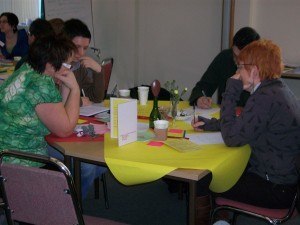Our Town Centres Tomorrow
The core principle to Julian Dobson’s approach in “How to Save Our Town Centres” is perhaps summarised in this single sentence:
“The thriving high streets and town centres of the 21st century will be those that rediscover how to maximise returns to their communities.” (page 127)
The concept of community is notoriously slippery and perhaps mostly we must fall back on “I know community when I see it”. We can say community is present where there is growth of sustained relationships between people committed to a particular place. Whilst there is a degree of trust required in any financial transaction, in large commercial chains it is primarily through written contracts and familiar branding; not so much through personal contact.
City Centres are Complex
So far, so simple. Dobson shows how complex our cities are and the many factors we need to consider. So, in the second part of the book, he has written chapters about:
- New approaches to the economy, many of which are well-known if neglected by the growth of multi-national corporations; we need to see a variety of business models and particularly models that allow money to circulate locally.
- Libraries and information centres. The very first retail co-operative had a library and meeting room above its store front. The Rochdale Pioneers understood the need for education and shared information.
- Consideration needs to be given to the spaces between the buildings in our town centres. Sheffield has seen many arguments over which shopping streets should be pedestrianised, the need for parking and control of traffic flow through the town centre. Some argue, restrictions on traffic have damaged footfall in the centre as much as out-of-town centres like Meadowhall. Dobson addresses these issues and the need for green spaces in town centres.
- Housing is important because people living there transform town centres. The type of accommodation is important but what many don’t realise is residents extend opening hours. A town centre where people live is less likely to close down at 5pm.
- The ownership of land and buildings is crucial. We’re all familiar with buildings standing empty that belong to someone who bought them as an investment and take a dog in a manger attitude until they can make their profit.
- And of course there is money and its administration through banks and other financial institutions. Debt is a real issue for many people and loan companies replace shops as they pull out-of-town centres. There are also alternative currencies and other incentives to shopping with local businesses to be explored.
Economic Development Equals Community Development
Dobson questions the approach to regeneration that brings together the great and the good. He writes:
“They fail to appreciate that economic development must encompass community development … this means considering not only what kind of places we want to create, but how they are to be run and in whose interests: who will control or influence what can happen in 5, 10, 20 or 50 years’ time and how to ensure our towns are no longer at the mercy of decisions taken hundreds or thousands of miles away – or even behind closed doors in the local town hall or chamber of commerce.” (page 262)
In my free e-book (see below) “Community Development is Dead! Long Live Community Development!”, I argue practitioners have ignored the local economy. The corporations have taken advantage of the neglect many local activists have practiced towards their local economy. They have their power because activists have refused to dirty their hands in trade. As a result community activity has become grant dependent and so unable to build sustainable programmes in their communities.
An Objection
And this brings me to an objection to Dobson’s argument. We cannot get there by concentrating solely on town centres. Town centres are one part of larger towns and cities with many suburban centres. And they too need regeneration. The big supermarkets recognise local shopping centres are important and wealthier centres usually house at least one major chain in direct competition with local businesses.
Local businesses not only base their activities outside their town centre because they can afford the premises but also because they value where they are. They build networks of suppliers and customers where they are.
We need a model that provides a framework for trade across the city, allowing customers to find local businesses not only in the centre but across the city. I’ve written about Hunters Bar in Sheffield, a distinct centre that draws people for recreational purposes, perhaps on an afternoon off work. In the same post, Spital Hill is another example of a local centre, where there is in embryo an Islamic shopping centre. There are many other similar places in the city. We need to find ways of supporting all this economic activity and the city centre can support these satellite centres.
This apart, “How to Save Our City Centres” is an essential contribution to the debate about the future of our cities, local economies and communities.


![By Australian Institute of Aboriginal and Torres Strait Islander Studies [CC BY-SA 4.0 (http://creativecommons.org/licenses/by-sa/4.0)], via Wikimedia Commons Audience in rows with keynote speakers](https://communitywebconsultant.com/wp-content/uploads/2015/08/Keynote_speaker_Professor_Taiaiake_Alfred_addresses_the_audience_during_a_symposium_on_cultural_strength_Stanner_Room_AIATSIS_11th_February_2015.jpg)